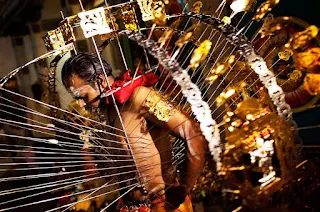 |
| Slava Kavadi @ Penang Thaipusam |
These types of dos and don'ts are rife in many Indic practices. All have them have a said ancient scientific to them.
Growing up, I had seen many who religiously performed annual penance for Lord Muruga on Thaipusam. I heard they had to undergo a gruelling 30-day or 14-day regime before going anywhere near the tent to initiate the ritual involving body piercings and feats that would befuddle them later.
It involved consuming two simple vegetarian meals a day. Abstinence from the luxuries of life is a must. That would mean no personal grooming, no manicure and pedicure, no footwear, no hot showers, avoidance of self-indulging activities, no entertainment, no TV and in the present day, it would mean no YouTube! The devotee can only sleep on a floor mat with no mattresses or pillows. All these were intended to prepare one mentally for the monumental task at hand. I heard of another person who would undergo similar self-torturing rituals to partake in the temple's annual fire walking ceremony to fete Goddess Kaaliamman.
The fantastic thing is that they would complete the task, return to everyday life the following day, and carry on as if nothing had happened.
Recently I heard a clip that gave a somewhat scientific explanation of why a Swami Ayyappan devotee fasts for 48 days. It seems that it took that much time for all the cells in the body to be replaced. That means that after 48 days, one is essentially walking with an entirely new set of cells in his body, hopefully as a rejuvenated, unique individual.The breaking of a coconut is the best symbol of what we aspire to. The rough, uneven exterior is broken to reveal a pristine white interior that can generate something new -a life. As the ancient sages used to quote, 'tat tvam asi', meaning 'you are that'. You are what you want to be. In other words, you are the architect of your life. Sometimes we do not know who it is 'that' we want to be. The Greeks also appreciated that.
At the entrance to Apollo temple at Delphi, is inscribed 'know thyself'. Sometimes, that can be a problem. We really do not know what we are capable of until we are pushed to the limit. The maxims that followed 'know thyself' were 'nothing to excess' and 'surety brings ruin'.









